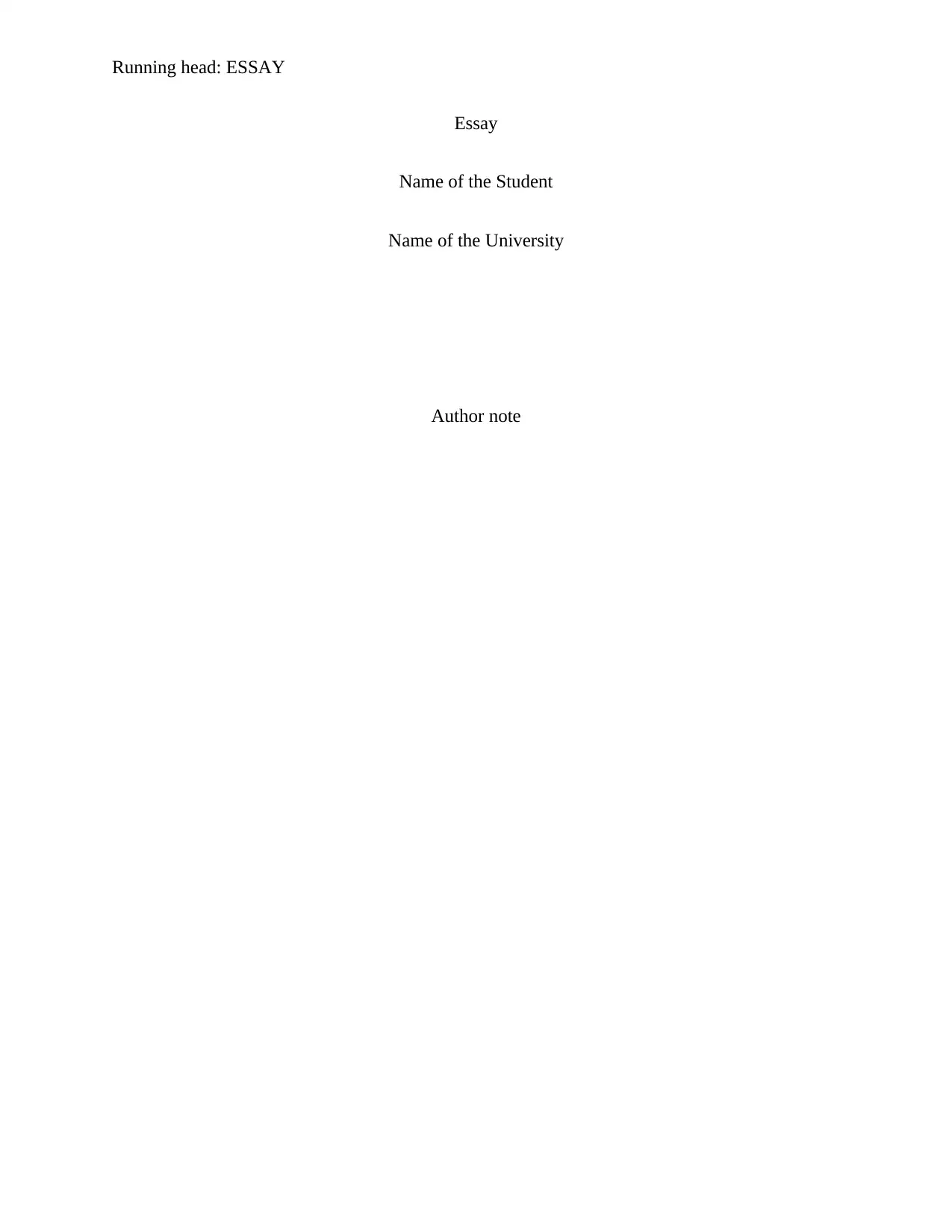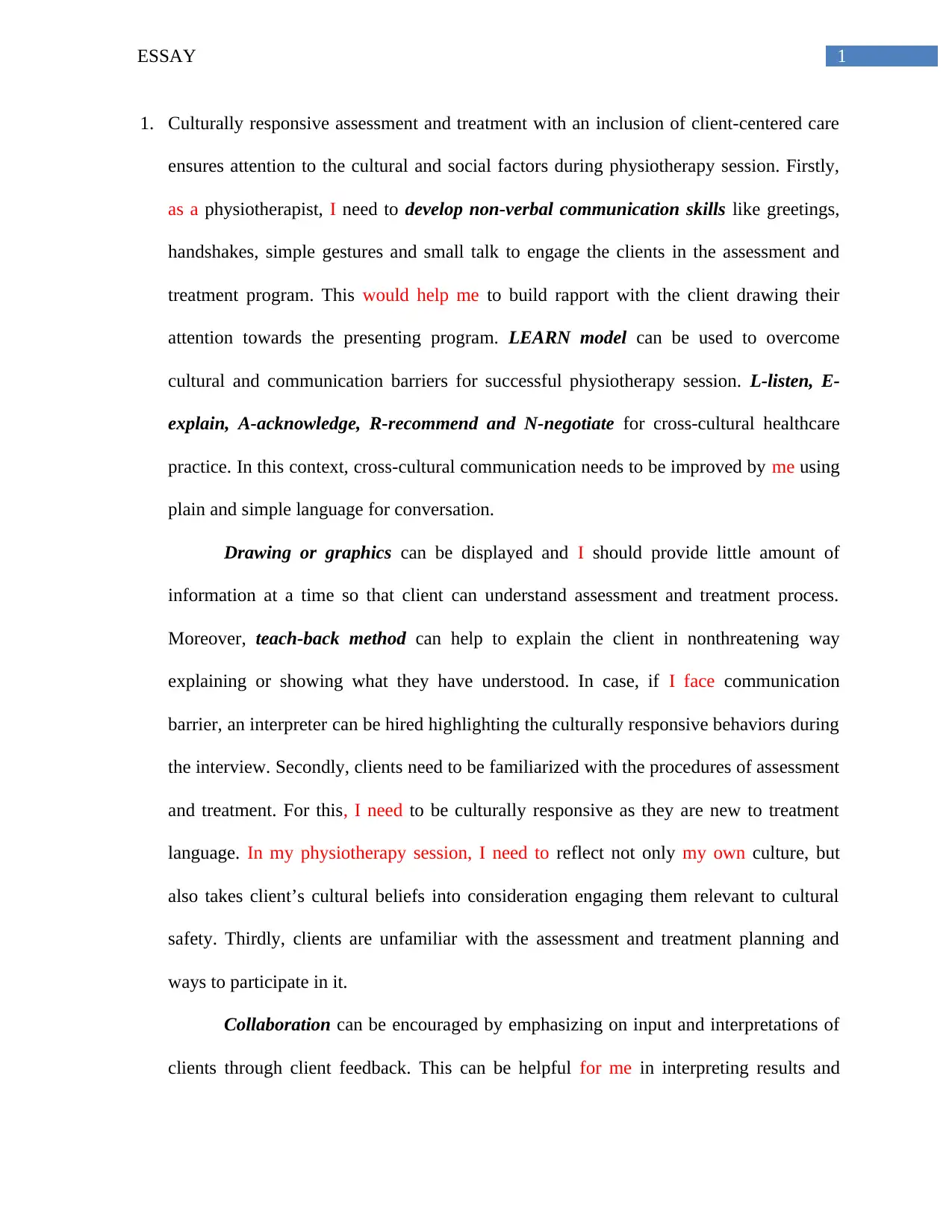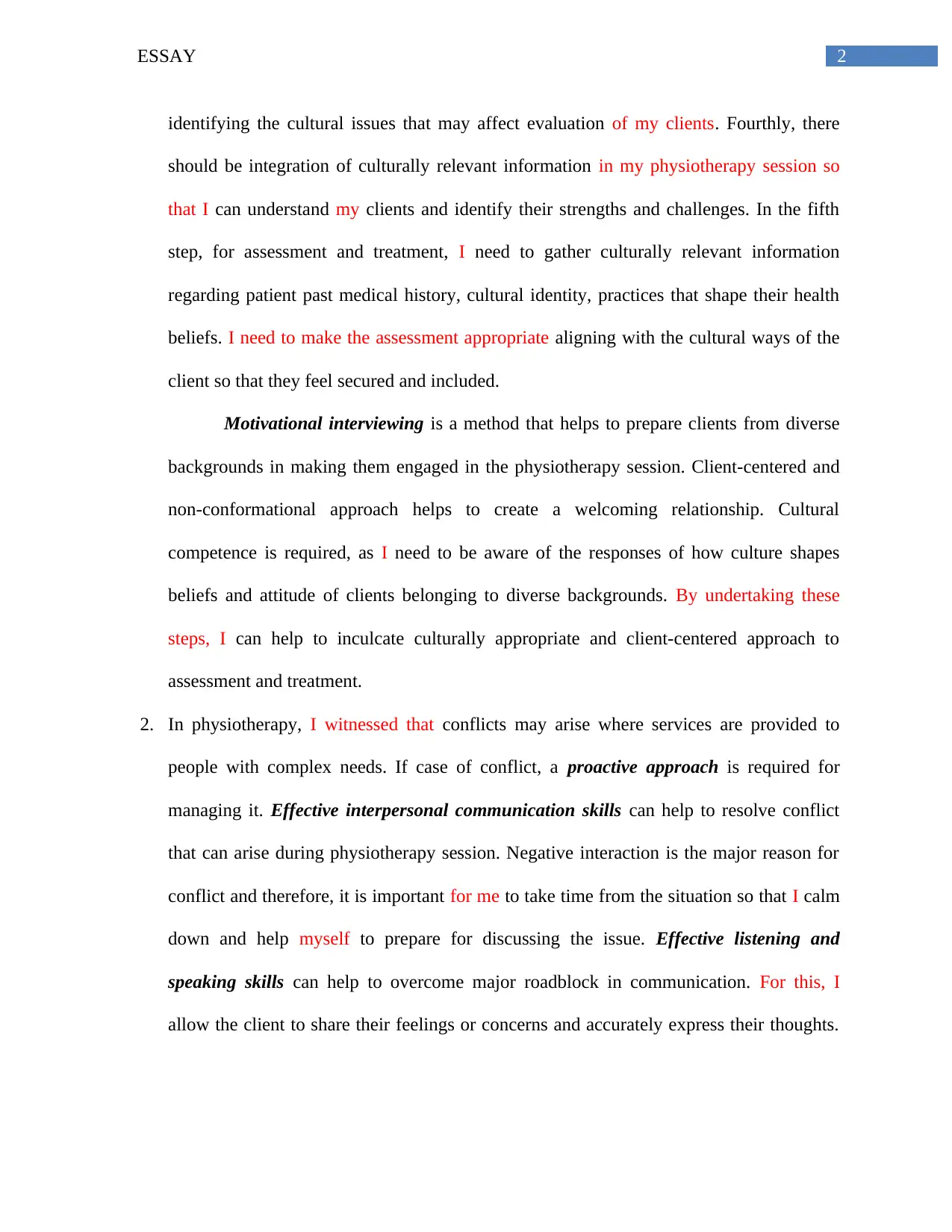Physiotherapy: Culturally Responsive, Client-Centered Assessment
VerifiedAdded on 2023/06/15
|4
|897
|431
Essay
AI Summary
This essay explores the importance of culturally responsive assessment and treatment in physiotherapy, emphasizing the need for physiotherapists to develop non-verbal communication skills and utilize models like LEARN to overcome cultural barriers. It highlights the significance of familiarizing clients with assessment and treatment procedures, integrating culturally relevant information, and employing motivational interviewing techniques. The essay also addresses conflict management strategies, focusing on effective interpersonal communication, active listening, and mental and physical resilience. Furthermore, it underscores the role of physiotherapists in advocating for their patients and the profession, emphasizing attributes like communication, collaboration, and perseverance for professional development. This approach ensures culturally appropriate and client-centered care, fostering a welcoming and effective physiotherapy experience.

Running head: ESSAY
Essay
Name of the Student
Name of the University
Author note
Essay
Name of the Student
Name of the University
Author note
Paraphrase This Document
Need a fresh take? Get an instant paraphrase of this document with our AI Paraphraser

1ESSAY
1. Culturally responsive assessment and treatment with an inclusion of client-centered care
ensures attention to the cultural and social factors during physiotherapy session. Firstly,
as a physiotherapist, I need to develop non-verbal communication skills like greetings,
handshakes, simple gestures and small talk to engage the clients in the assessment and
treatment program. This would help me to build rapport with the client drawing their
attention towards the presenting program. LEARN model can be used to overcome
cultural and communication barriers for successful physiotherapy session. L-listen, E-
explain, A-acknowledge, R-recommend and N-negotiate for cross-cultural healthcare
practice. In this context, cross-cultural communication needs to be improved by me using
plain and simple language for conversation.
Drawing or graphics can be displayed and I should provide little amount of
information at a time so that client can understand assessment and treatment process.
Moreover, teach-back method can help to explain the client in nonthreatening way
explaining or showing what they have understood. In case, if I face communication
barrier, an interpreter can be hired highlighting the culturally responsive behaviors during
the interview. Secondly, clients need to be familiarized with the procedures of assessment
and treatment. For this, I need to be culturally responsive as they are new to treatment
language. In my physiotherapy session, I need to reflect not only my own culture, but
also takes client’s cultural beliefs into consideration engaging them relevant to cultural
safety. Thirdly, clients are unfamiliar with the assessment and treatment planning and
ways to participate in it.
Collaboration can be encouraged by emphasizing on input and interpretations of
clients through client feedback. This can be helpful for me in interpreting results and
1. Culturally responsive assessment and treatment with an inclusion of client-centered care
ensures attention to the cultural and social factors during physiotherapy session. Firstly,
as a physiotherapist, I need to develop non-verbal communication skills like greetings,
handshakes, simple gestures and small talk to engage the clients in the assessment and
treatment program. This would help me to build rapport with the client drawing their
attention towards the presenting program. LEARN model can be used to overcome
cultural and communication barriers for successful physiotherapy session. L-listen, E-
explain, A-acknowledge, R-recommend and N-negotiate for cross-cultural healthcare
practice. In this context, cross-cultural communication needs to be improved by me using
plain and simple language for conversation.
Drawing or graphics can be displayed and I should provide little amount of
information at a time so that client can understand assessment and treatment process.
Moreover, teach-back method can help to explain the client in nonthreatening way
explaining or showing what they have understood. In case, if I face communication
barrier, an interpreter can be hired highlighting the culturally responsive behaviors during
the interview. Secondly, clients need to be familiarized with the procedures of assessment
and treatment. For this, I need to be culturally responsive as they are new to treatment
language. In my physiotherapy session, I need to reflect not only my own culture, but
also takes client’s cultural beliefs into consideration engaging them relevant to cultural
safety. Thirdly, clients are unfamiliar with the assessment and treatment planning and
ways to participate in it.
Collaboration can be encouraged by emphasizing on input and interpretations of
clients through client feedback. This can be helpful for me in interpreting results and

2ESSAY
identifying the cultural issues that may affect evaluation of my clients. Fourthly, there
should be integration of culturally relevant information in my physiotherapy session so
that I can understand my clients and identify their strengths and challenges. In the fifth
step, for assessment and treatment, I need to gather culturally relevant information
regarding patient past medical history, cultural identity, practices that shape their health
beliefs. I need to make the assessment appropriate aligning with the cultural ways of the
client so that they feel secured and included.
Motivational interviewing is a method that helps to prepare clients from diverse
backgrounds in making them engaged in the physiotherapy session. Client-centered and
non-conformational approach helps to create a welcoming relationship. Cultural
competence is required, as I need to be aware of the responses of how culture shapes
beliefs and attitude of clients belonging to diverse backgrounds. By undertaking these
steps, I can help to inculcate culturally appropriate and client-centered approach to
assessment and treatment.
2. In physiotherapy, I witnessed that conflicts may arise where services are provided to
people with complex needs. If case of conflict, a proactive approach is required for
managing it. Effective interpersonal communication skills can help to resolve conflict
that can arise during physiotherapy session. Negative interaction is the major reason for
conflict and therefore, it is important for me to take time from the situation so that I calm
down and help myself to prepare for discussing the issue. Effective listening and
speaking skills can help to overcome major roadblock in communication. For this, I
allow the client to share their feelings or concerns and accurately express their thoughts.
identifying the cultural issues that may affect evaluation of my clients. Fourthly, there
should be integration of culturally relevant information in my physiotherapy session so
that I can understand my clients and identify their strengths and challenges. In the fifth
step, for assessment and treatment, I need to gather culturally relevant information
regarding patient past medical history, cultural identity, practices that shape their health
beliefs. I need to make the assessment appropriate aligning with the cultural ways of the
client so that they feel secured and included.
Motivational interviewing is a method that helps to prepare clients from diverse
backgrounds in making them engaged in the physiotherapy session. Client-centered and
non-conformational approach helps to create a welcoming relationship. Cultural
competence is required, as I need to be aware of the responses of how culture shapes
beliefs and attitude of clients belonging to diverse backgrounds. By undertaking these
steps, I can help to inculcate culturally appropriate and client-centered approach to
assessment and treatment.
2. In physiotherapy, I witnessed that conflicts may arise where services are provided to
people with complex needs. If case of conflict, a proactive approach is required for
managing it. Effective interpersonal communication skills can help to resolve conflict
that can arise during physiotherapy session. Negative interaction is the major reason for
conflict and therefore, it is important for me to take time from the situation so that I calm
down and help myself to prepare for discussing the issue. Effective listening and
speaking skills can help to overcome major roadblock in communication. For this, I
allow the client to share their feelings or concerns and accurately express their thoughts.
⊘ This is a preview!⊘
Do you want full access?
Subscribe today to unlock all pages.

Trusted by 1+ million students worldwide

3ESSAY
Active listening skills also ensure that client is being heard and respected. In this way, I
can resolve conflict by understanding what my client wants.
I adapt many strategies to bolster my mental and physical resilience. I have to
interact with people with varying challenging needs and that might affect their ability to
deal with adversity and discomfort. For this, I try to pump up their positivity by reflecting
and appreciating their positive experiences wherever and whenever it occurs. This makes
them to be optimally positive and uplift their confidence. I also appreciate kindness from
others whenever they receive, as gratitude helps them gain resilience mentally. For
physical resilience, I maintain a regular routine of hygienic habits and good health so that
I develop the ability to solve problems and respond to them. I also spend time outdoors
and socialize with others as it helps me to combat depression and anxiety. In my
physiotherapy profession, I promote advocacy within my scope of practice by ensuring
that every client has appropriate access to physiotherapy services as I have a commitment
towards my profession as a part of professional life or entry-to-practice. Attributes like
communication, collaboration, management, scholarly practice, perseverance, passion
and humility are viewed as excellent skills for advocacy. Moreover, these attributes help
me to understand competence in advocacy for my clients as well as in my professional
development. In this way, I can be successful in advocating for my clients and effective
in changing the physiotherapy landscape.
Active listening skills also ensure that client is being heard and respected. In this way, I
can resolve conflict by understanding what my client wants.
I adapt many strategies to bolster my mental and physical resilience. I have to
interact with people with varying challenging needs and that might affect their ability to
deal with adversity and discomfort. For this, I try to pump up their positivity by reflecting
and appreciating their positive experiences wherever and whenever it occurs. This makes
them to be optimally positive and uplift their confidence. I also appreciate kindness from
others whenever they receive, as gratitude helps them gain resilience mentally. For
physical resilience, I maintain a regular routine of hygienic habits and good health so that
I develop the ability to solve problems and respond to them. I also spend time outdoors
and socialize with others as it helps me to combat depression and anxiety. In my
physiotherapy profession, I promote advocacy within my scope of practice by ensuring
that every client has appropriate access to physiotherapy services as I have a commitment
towards my profession as a part of professional life or entry-to-practice. Attributes like
communication, collaboration, management, scholarly practice, perseverance, passion
and humility are viewed as excellent skills for advocacy. Moreover, these attributes help
me to understand competence in advocacy for my clients as well as in my professional
development. In this way, I can be successful in advocating for my clients and effective
in changing the physiotherapy landscape.
1 out of 4
Related Documents
Your All-in-One AI-Powered Toolkit for Academic Success.
+13062052269
info@desklib.com
Available 24*7 on WhatsApp / Email
![[object Object]](/_next/static/media/star-bottom.7253800d.svg)
Unlock your academic potential
Copyright © 2020–2025 A2Z Services. All Rights Reserved. Developed and managed by ZUCOL.



